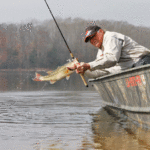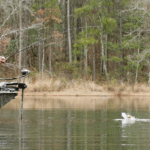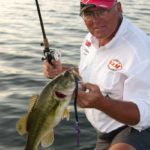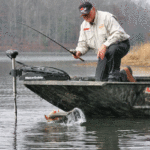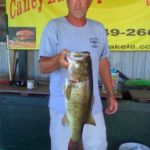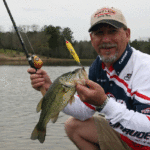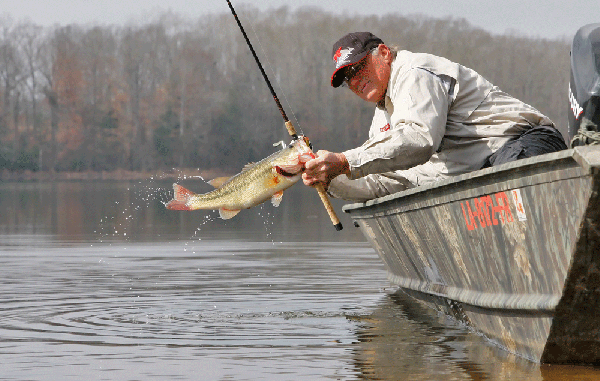
Caney Lake once turned out massive fish, and there are still some beasts lurking in the reservoir. Here some tips on how to put those lunkers in the boat.
It doesn’t take much to get a typical Louisiana bass angler out of bed early during June. He knows he’s not going to be out there on the lake all that long anyway.
After launching his boat in the dark, he falls into a predictable routine that includes a few topwater bites right at dawn. Maybe a slow-rolled spinnerbait around the grass just after that. And he wraps up his trip with a plastic worm around a few docks before retiring for an afternoon nap under a window unit.
After launching his boat in the dark, he falls into a predictable routine that includes a few topwater bites right at dawn. Maybe a slow-rolled spinnerbait around the grass just after that. And he wraps up his trip with a plastic worm around a few docks before retiring for an afternoon nap under a window unit.
Ron Aulds isn’t your typical Louisiana angler.
While you’re catching 40 winks under a 5,000 BTU breeze, this West Monroe angler is out on Caney Lake pulling big worms through even bigger brush piles.
If fact, this very time last year, Aulds discovered a 7-foot channel at the end of a 2-foot-deep point that peaked back up into a ridge on its other side. There were a couple brush tops in the middle of the 9-foot-deep channel not 50 yards from land.
“Those big bass stacked up on those brush tops, and I whacked on them all summer,” Aulds recalled. “I caught at least eight fish, all over 6 pounds with the biggest bumping 9.
“And I caught every one of them anywhere from noon to late afternoon.”
That’s exactly the time when most of you aren’t out on the water this time of year. And that’s exactly what you’re missing out on if you choose to sleep in the shade rather than fish in the sun.
If you haven’t been to Caney Lake lately, you’re going to find a lake that fishes a lot differently than you remember. The lake has undergone several changes in fish-holding cover and fish-producing patterns.
But to hear Aulds tell it, Caney Lake is setting up to be a great place to fish this summer.
“It’s coming back, to some degree,” he said in reference to Caney’s dramatic fall from grace after the hydrilla disappeared. “A good bit of grass is coming back; not so much in the main lake, and I haven’t seen any hydrilla, but there is a lot of what I believe to be milfoil in the backs of some of the creeks.”
Most of the backs of the creeks actually offer a great combination of grass and dollar pads and, while these spots offer excellent early and late topwater frog action, that’s not how Aulds catches big bass at Caney.
Rather than fishing natural vegetation at the backs of the creeks, Aulds heads out to the main lake and fishes man-made brush piles, which are prime targets because most of the natural brush that used to cover the points and ridges has rotted out over the years.
“Really, most of the cover we have to fish are the docks and brushpiles people have put out,” he said. “And there is a considerable amount of brush people have put out. In fact, there’s so many man-made brush piles in the lake now that some of the better spots have so much brush that the fish have quit using them.”
That has made finding brush piles in the less obvious areas critical to locating Caney’s still-impressive population of very large bass.
It takes some work. With as much experience as Aulds has on the lake, even he had to do some new looking around last year, and he pinpointed the zone between Boggy and Brown’s Landing.
“I cranked the outboard and turned on my GPS and depth finder and went riding around,” he explained. “I marked 60 spots by getting out on the big deepwater flats and looking for drop-offs from 10 to 15 feet.
“When I found that contour line, I zigzagged back and forth looking for any little cut or point on that contour line, and that’s where I found the brush.”
Aulds estimated that over half of the new spots he found would be considered dead brush because they haven’t shown that they consistently hold bass. However, that still leaves him with 30 new spots around which he can rotate throughout an afternoon.
One of the things he considers important in finding productive brush piles is finding those that have most recently been dropped into the lake.
He told a story about how he and another angler had been fishing the same brush pile for a few weeks. Even though this was a productive spot, the other angler collected some new brush and dropped it hardly 70 yards from this pile.
“It was on the same break line, and it wasn’t anything special other than it was new brush,” Aulds said. “It could have been because of the pressure, but that new top pulled every fish off the old one.
“He sat right there and whacked them right in front of me.”
Other than new brush, Aulds explained that anglers should focus on those tree tops that are closest to the drops and to look for the ones that have lots of baitfish around them.
By June, most of these bass — when they are not feeding — will be suspended out in deeper water just kind of roaming around with the shad. This is when anglers can start targeting actively schooling fish on the surface, but Aulds says that’s not the most consistent way to catch big bass.
“They have their feeding periods when they pull up on those deeper humps and deeper brush,” he explained. “And if you’re on a piece of brush when they pull in on it, you’ll catch them. These bass are especially plastic-related, and if you aren’t fishing the brush with some kind of plastic it’s hard to catch them.”
Many anglers who fish plastics in the deep brush at Caney Lake prefer big worms, and Aulds is no exception.
He favors junebug, watermelon and red shad Zoom Ol’ Monster worms rigged with 5/16-ounce weights and 5/0 Owner EWG hooks tied to 20-pound-test green CXX P-Line.
He reasoned that the 5/16-ounce weight works best for him because he’s not worried about how slow it falls: These fish are generally suspended and spooky, so he wants to make a long cast and get it on down in the brush.
And he likes the big line and big hook for durability in the heavy wood cover. Aulds admits that he would get more bites on flouracarbon or even lighter line for that matter, but he’s not willing to give up an inch of durability for one more bite, and he knows that line with little stretch can pop under pressure.
“I’m looking to get fish in the boat,” he said. “If you’re using 15-pound line and I’m using 20-pound, I’m going to get him in before you will.
“These are strong fish. Last year, I took a guy and he had one break his hook one day and pop his 15-pound line the next day on a fish that we saw was every bit of 10 pounds.”
After allowing his worm to settle to the bottom, Aulds begins to slowly drag it through the brush pile by pulling his rod tip up rather than to the side. This imparts a slow yo-yo action that pulls his worm up to and over the many limbs around the pile.
“You can feel your worm pulling up on a limb,” he noted. “When I feel it actually hit that limb, I stop it because a lot of times, that’s right when they want to get it.
“If nothing bites, I pull it over and let it drop straight back down into the pile.”
Aulds says he can tell when there are a couple good fish in a pile by the way they bite the worm. If they “thump the dog out of it,” that’s a good indicator that they are really onto the worm bite and want to get their prey away from any other fish in the pile.
“When you feel him thump it, he’s on and you’ll feel he’s heavy and going out the backside of that top,” Aulds explained.
With so many tops to fish, Aulds generally gives each one only about 15 minutes before heading off to fish another one. However, if he’s fishing a top he knows the fish are on because he has caught them there within the last week or so, he may give them about 45 minutes to see if they move up to eat.
On some tops he’s caught fish on all summer long, and those are the ones he sits on even longer because he knows the fish are going to eventually move in. And these are the kinds of tops that he knows when he gets a bite it’s going to be a fish that will top 7-pound.
And since this brush-pile bass bite lasts well into the afternoon and even into the first hours of night, rather than you having trouble getting out of bed, your wife just might have trouble getting you home and into it.
